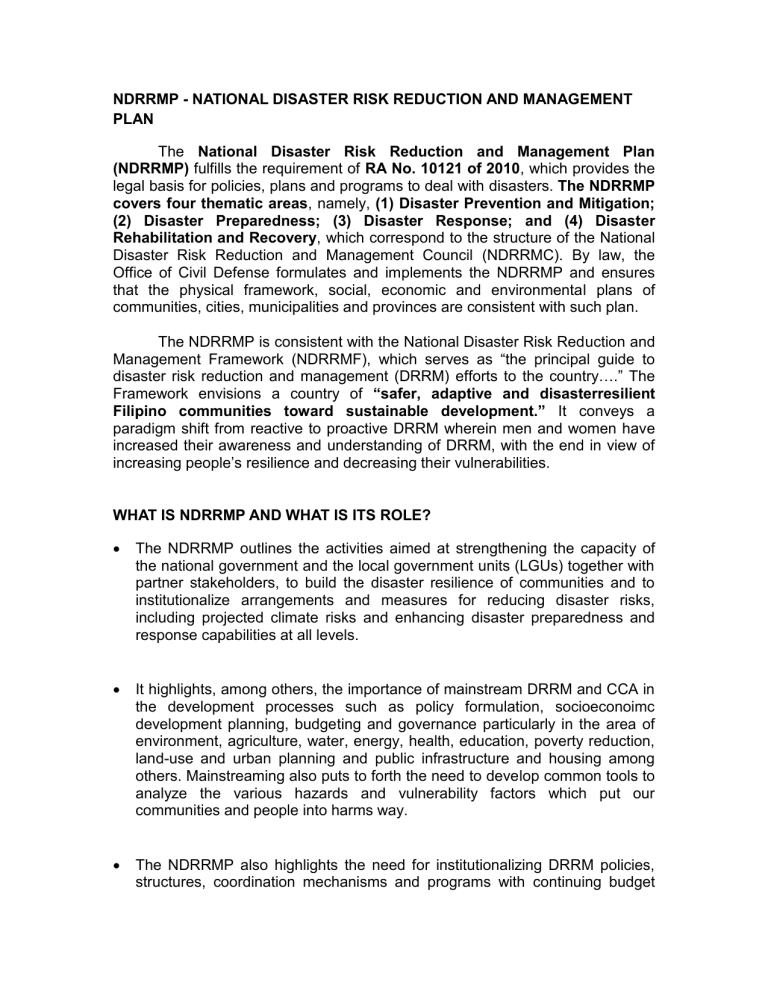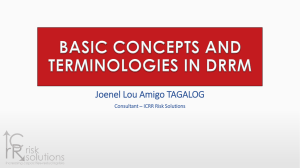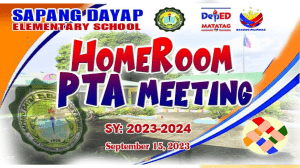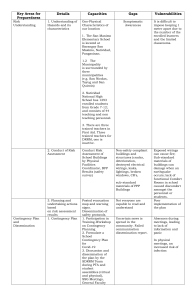
NDRRMP - NATIONAL DISASTER RISK REDUCTION AND MANAGEMENT PLAN The National Disaster Risk Reduction and Management Plan (NDRRMP) fulfills the requirement of RA No. 10121 of 2010, which provides the legal basis for policies, plans and programs to deal with disasters. The NDRRMP covers four thematic areas, namely, (1) Disaster Prevention and Mitigation; (2) Disaster Preparedness; (3) Disaster Response; and (4) Disaster Rehabilitation and Recovery, which correspond to the structure of the National Disaster Risk Reduction and Management Council (NDRRMC). By law, the Office of Civil Defense formulates and implements the NDRRMP and ensures that the physical framework, social, economic and environmental plans of communities, cities, municipalities and provinces are consistent with such plan. The NDRRMP is consistent with the National Disaster Risk Reduction and Management Framework (NDRRMF), which serves as “the principal guide to disaster risk reduction and management (DRRM) efforts to the country….” The Framework envisions a country of “safer, adaptive and disasterresilient Filipino communities toward sustainable development.” It conveys a paradigm shift from reactive to proactive DRRM wherein men and women have increased their awareness and understanding of DRRM, with the end in view of increasing people’s resilience and decreasing their vulnerabilities. WHAT IS NDRRMP AND WHAT IS ITS ROLE? The NDRRMP outlines the activities aimed at strengthening the capacity of the national government and the local government units (LGUs) together with partner stakeholders, to build the disaster resilience of communities and to institutionalize arrangements and measures for reducing disaster risks, including projected climate risks and enhancing disaster preparedness and response capabilities at all levels. It highlights, among others, the importance of mainstream DRRM and CCA in the development processes such as policy formulation, socioeconoimc development planning, budgeting and governance particularly in the area of environment, agriculture, water, energy, health, education, poverty reduction, land-use and urban planning and public infrastructure and housing among others. Mainstreaming also puts to forth the need to develop common tools to analyze the various hazards and vulnerability factors which put our communities and people into harms way. The NDRRMP also highlights the need for institutionalizing DRRM policies, structures, coordination mechanisms and programs with continuing budget appropriation on DRR from national down to local levels. Through permanent mechanisms, competency and science-based capacity building activities can be done, alongside the nurturing of continuous learning through knowledge development and management of good DRRM practices on the ground. National Disaster Risk Reduction and Management Plan 2011-2028. The NDRRMP sets down the expected outcomes, outputs, key activities, indicators, lead agencies, implementing partners and timelines under each of the four distinct yet mutually reinforcing thematic areas. The goals of each thematic area lead to the attainment of the country’s overall DRRM vision, as graphically shown below. The NDDRMP goals are to be achieved by 2028 through 14 objectives, 24 outcomes, 56 outputs, and 93 activities. The 24 outcomes, with their respective overall responsible agencies, are summarized below.






